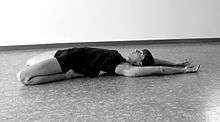Yin yoga
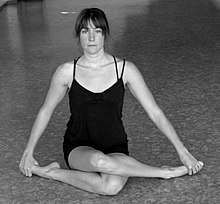
Yin yoga is a slow-paced style of yoga with postures, or asanas, that are held for longer periods of time—for beginners, it may range from 45 seconds to two minutes; more advanced practitioners may stay in one asana for five minutes or more.[2]
Yin yoga poses apply moderate stress to the connective tissues of the body—the tendons, fascia, and ligaments—with the aim of increasing circulation in the joints and improving flexibility. A more meditative approach to yoga, yin aims at cultivating awareness of inner silence, and bringing to light a universal, interconnecting quality.[3]
Yin yoga's teaching in the Western world, beginning in the late 1970s, was founded by martial arts expert and Taoist yoga teacher Paulie Zink.[4][5][6] Yin yoga is now being taught across North America and in Europe, due in large part to the teaching activities of Yin yoga teachers and developers Paul Grilley and Sarah Powers.[7][8][9][10] Yin yoga as taught by Paul Grilley and Sarah Powers is not intended as a complete practice in itself, but rather as a complement to more active forms of yoga and exercise.[11] However, Paulie Zink's approach includes the full range of Taoist yoga, both yin and yang, and is intended to be a complete practice in itself.[12]:21
History
Roots in India and China
The practice of holding yoga postures or asanas for extended periods of time has always been a significant part of traditional yoga practice, both in the hatha yoga tradition of India and in the Taoist yoga tradition of the greater China area. Contemporary schools of hatha yoga have also advocated holding some poses for relatively long periods of time. For example, BKS Iyengar recommended holding the Supta Virasana asana (reclining hero pose) for 10–15 minutes.[12]:12 For that matter, long-held stretches have been and are commonly recommended in other physical disciplines, such as gymnastics and dance, to increase flexibility. For example, ballerinas are commonly counselled to open their hips by approximating the splits position for long periods of time.[12]:28
Taoist yoga practices from China also included yin-style poses in the Taoist system of "Internal Alchemy"—practiced for the purpose of improving health and longevity.[12]:15 Techniques for stretching of this type have been practiced for centuries in China and Taiwan as part of Taoist yoga, which was sometimes known as Dao Yin. Taoist priests taught long-held poses, along with breathing techniques, to Kung Fu practitioners beginning 2000 years ago, to help them fully develop their martial arts skills.[13]
Beginnings in the West
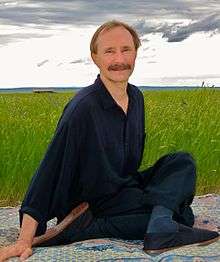
The practice of performing series of long-held floor poses one after the other was first introduced in North America in the late 1970s by Paulie Zink, a martial arts champion and Taoist yoga teacher and practitioner.[14] Zink trained for 10 years, during the 1970s, in daily private classes with Cho Chat Ling, a Kung-Fu and Taoist yoga master from Hong Kong specializing in Tai shing pek kwar, or Monkey Kung Fu. (In Kung Fu, the movements of animals are closely studied and emulated, inspiring many of the movements taught in Kung Fu.) At the end of the decade, Zink entered the Long Beach International Karate Championships in 1981, 1982 and 1983 and won Grand Champion in the "weapons forms" category in all three years, and was also Grand Champion in the "empty hands" category in two of those years.[15] Black Belt magazine named him Kung Fu artist of the year in 1989.[16] Noted in the Kung Fu community for his exceptional personal flexibility,[17] Zink also emphasized flexibility training in his martial arts classes as a method to develop agility, power and endurance.[18]
In the late 70s, Zink began, separate from his martial arts classes, to teach a synthesis of hatha yoga with a range of disciplines from Taoist Yoga, as well as postures, movements and insights that he had developed himself. He later called this synthesis "Yin and Yang yoga," or often "Yin yoga" for short.[12]:19[19][20] Paulie Zink, even more than his master, was convinced of the effectiveness of holding yoga poses for long periods of time in order to improve flexibility.[12]:20
In his first years of teaching, many of Zink's students were martial artists who had developed strong but tight muscles, and he taught them only beginner level Taoist yoga, focusing on long-held yin poses to allieviate their lack of flexibility. However, as more students came he began to teach more advanced levels. He explained that in order to develop full flexibility, the student must restore his own primal nature, through several Taoist yoga practices, as follows: yin asanas— mostly sitting or lying postures; yang asanas— more active, strenuous postures; Taoist Flow yoga— both yin and yang yoga postures practiced in continuous, smooth and circular motions; Chi Kung (or Qigong)— involving simple and gentle movement and breathing techniques; and Taoist alchemy— based upon the Taoist theory of the five elements used in Chinese medicine.[12]:19 [20] Taoist Alchemy is a method of embodying the energetic attributes of various animals and enlivening the five alchemical elements believed to be contained in the body's energetic field. The five transforming energies of Earth, Metal, Water, Wood, and Fire animate distinct qualities in the body such as calm, strength, fluidity, springiness and lightness, respectively.
Paul Grilley and Sarah Powers
Paul Grilley, a yoga teacher who later became a major proponent of Yin yoga,[8][10][21] first saw Paulie Zink on a public access television talk show in California in 1988, performing a demonstration of Taoist yoga practices that he used in teaching martial arts. Impressed by both his exceptional physical flexibility and his gentle, restrained manner, absent the arrogance he had observed in other martial artists, he sought Zink out and studied with him for about one year.[22]
Earlier, Grilley had formally studied anatomy for two years in his home state, Montana, under Dr. Garry Parker. He moved to California and continued studying anatomy at UCLA. There, he also regularly taught hatha yoga for several years—active forms including Ashtanga and Bikram's--and managed a yoga studio.[12]:21 In 1989, Grilley met Hiroshi Motoyama, a Japanese scholar and yogi,[23] who had researched the physiology of Traditional Chinese Medicine and written on it extensively.[24] Motoyama was especially interested in the physiology of the meridians, or subtle pathways and vessels, and the qi or subtle energy hypothesized to flow through or get stored in them. These are both fundamental concepts in Chinese medicine and acupuncture. He related these to the parallel concepts of the nadi pathways and chakras of Indian yoga, and the prana said to be carried within them.[25]
Grilley now began to teach a fusion of the Yin poses he had learned from Zink with his own knowledge of hatha yoga and anatomy, and the teachings of Motoyama.[12]:22 [26] He created yin sequences with aims similar to that of an acupuncturist.[27] Yin teacher and author Ulrica Norberg says that Grilley, based on this fusion of knowledge, "evolved Yin yoga further."[28] Bernie Clark, a leading Yin yoga author and teacher [29] said that Grilley's synthesis of anatomy, Taoist yoga, and meridian theory "resonated with many people who recognized the benefits of the practice and related to Paul's model of the body/mind/soul." [12]:22
One of Grilley's students, Sarah Powers, also a yoga teacher, began teaching yoga in Grilley's style. She incorporated Buddhist psychology in her teaching of Yin yoga and put even more emphasis on targeting the meridian systems for health and enlightenment than did Grilley. Much of her book, Insight Yoga, is devoted to an explanation of Yin yoga sequences designed to enhance the flow of qi as understood in Traditional Chinese Medicine.[30] She also emphasized a conscious and systematic approach to breathing during yin practice.[31]
Grilley at first called it Taoist yoga, in deference to the term Paulie Zink had used. Sarah Powers pointed out that the yoga she and Grilley were teaching was different from the Taoist practice being taught by Zink. She suggested they use the term Yin yoga, to differentiate it from the various forms of Taoist yoga being taught. She and Grilley adopted the name.[12]:22 Later, Paulie Zink also began calling his teachings Yin yoga, though as a short form for his preferred term, "Yin and Yang Yoga."[32]
Teaching spreads
Sarah Powers, already a renowned yoga teacher who traveled widely giving yoga workshops, now began also teaching Yin yoga in her tours.[33] When her students asked for more information, she would refer them to Paul Grilley, who began receiving requests to travel and offer seminars. Paulie Zink continued teaching Yin yoga in his own style, combined with other elements of Taoist yoga. Powers and Grilley began offering Yin yoga teacher training courses, as did Paulie Zink. Over the next 10 years, Yin yoga became available all over North America and in Europe, through yoga classes, and via DVDs and books.[7] In 2002, Grilley published the book, Yin yoga: A Quiet Practice (and in 2012 a revised edition titled, Yin yoga Principles and Practice). In 2006, Biff Mithoefer, a student of Grilley and Powers, published The Yin yoga Kit, which included a detailed volume of instruction as well as a DVD. In 2008, Sarah Powers published the book, Insight Yoga, which teaches Yin yoga sequences and more active (or yang) yoga sequences as a complement to yin poses.[34] Bernie Clark, also a student of Grilley and Powers, began the website, yinyoga.com, in 2006 and published his book, The Complete Guide to Yin yoga in 2012. Both Grilley and Powers have also released instructional DVDs on Yin yoga, as has Paulie Zink.
Practice
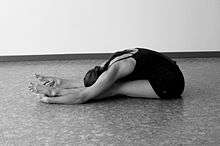
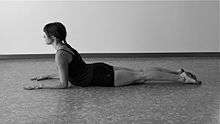
Paulie Zink's approach to Yin yoga consists of both yin and yang postures, and also incorporates movement in between postures as a yang element.[39] In contrast, Yin yoga sessions taught by Paul Grilley and Sarah Powers consist of a series of long-held, passive floor poses—which Grilley learned from Paulie Zink [26]—that primarily affect the lower part of the body—the hips, pelvis, inner thighs, lower spine—about 18 - 24 in number. These areas are especially rich in connective tissues, the "loading" of which (Yin yoga teachers avoid the word "stretching") is a main focus in this style of yoga.[40] Grilley and Powers both emphasize the value of more active, yang-type poses, but do not generally mix yin and yang styles.
Yin yoga employs specific sequences of poses aimed at stimulating particular meridians, or subtle channels, as understood in Traditional Chinese Medicine (TCM),[41] the far eastern counterpart of India's Ayurveda; the system of medicine claims that there are energy channels of the subtle body, called nadi (Sanskrit for "stream"), with the ida, pingala, and sushumna as the principal or most important nadis.[42]
During the long hold times of the yin asanas, teachers usually give "dharma talks," informal monologues drawing from a variety of sources, according to teachers' choice. They will often explain the physiology and anatomy of poses, including the location of the meridian lines being affected. They may tell traditional Buddhist stories, recite poetry, sing songs, or reflect on their own experience.[43]
In keeping with its roots in Taoist yoga, Paulie Zink says that Yin yoga has a deeper purpose: to "open the heart and invoke the primal self."[20] Sarah Powers says one of the primary objectives of yin practice is the cultivation of inner stillness.[3]
Principles
Yin and yang
Yin yoga is based on the Taoist concepts of yin and yang, opposite and complementary principles in nature. Yin could be described as stable, immobile, feminine, passive, cold, and downward moving. Yang is understood to be changing, mobile, masculine, active, hot, and upward moving. The sun is considered yang, the moon yin.[44] In the body, the relatively stiff connective tissues (tendons, ligaments, fascia) are yin, while the more mobile and pliable muscles and blood are yang. More passive asanas in yoga are considered yin, whereas the more active, dynamic asanas are yang, because they stimulate the muscles and generate heat.[40]
Distinction from hatha yoga
Although many Yin yoga poses or asanas closely resemble the asanas in Indian hatha yoga, they have different names, in part to alert those who are familiar with similar poses in hatha yoga not to perform them in the same way.[44] In general, the poses of Yin yoga are performed with very little muscular exertion. For example, in the Seal pose, in which a practitioner lies face down and then raises the trunk upward, the upward movement is gradual and entirely supported by the arms, and the legs are relaxed. But in the Cobra or Bhujangasana of hatha yoga, the practitioner actively curves the spine upward in an arc using arms and lower back muscles, and reaches back with the legs strongly.[38]
Physiology
Muscles account for about forty percent of the resistance against the body's flexibility, while connective tissue accounts for about fifty percent.[45] The intensity and physical benefits of Yin yoga practice depend on two variables: duration of the asana, and the temperature of the muscle. Asanas are usually held for five minutes, but can be held for as long as twenty. Because of the long duration of asanas, it is said that patience is another of the key values cultivated by Yin yoga.
It is usually recommended that Yin yoga be practiced when the muscles are not yet warmed up. When the muscles are cold, they are less elastic, and more stress will be transferred to the connective tissue. However, this is a general rule and for some people, it is better to stay a bit warm while practicing. Because this style of yoga does not generate bodily heat, yin teachers recommend keeping the temperature of the room a little higher than usual.[12]:33 During yin asanas, muscles are relaxed to avoid tetany, or muscle spasm, which could result from engaging muscles for long periods.
Publications
- Yin yoga: Principles and Practice," 10th anniversary edition, Paul Grilley, White Cloud Press, Ashland, Oregon 2012 ISBN 978-1-883991-43-2
- Yin yoga: Outline of A Quiet Practice, Paul Grilley, White Cloud Press, Ashland, Oregon 2002 ISBN 978-1-935952-70-1 (The original version of this book is titled Taoist Yoga: Outline Of A Quiet Practice by Paul Grilley)
- Insight Yoga, Sarah Powers, Shambahala Publications Inc., Boston, MA 2008 ISBN 978-1-59030-598-0
- The Complete Guide to Yin yoga: the Philosophy & Practice of Yin yoga, Bernie Clark, White Cloud Press, Ashland, Oregon 2012 ISBN 978-1-935952-50-3
- Yinsights: A Journey into the Philosophy and Practice of Yoga, Bernie Clark, Cardinal Publishing Group, Indianapolis 2007 ISBN 978-0-9687665-1-4
Notes
- ↑ "Yoga for Travelers". Retrieved January 1, 2017.
- ↑ Loriggio, Paola. "Slow stretch, side of soul: Tight muscles, tough thoughts demand attention at Yin yoga". Toronto Star. Missing or empty
|url=(help);|access-date=requires|url=(help) - 1 2 Sexton, Michael (Nov 13, 2009). "YJ Interview: The Delight of Insight". YogaJournal.com. Yoga Journal. Retrieved 16 November 2014.
- ↑ Norberg, Ulrica (2014). Yin yoga: and individualized approach to balance, health, and whole self well-being. New York: Skyhorse Publishing. p. 23. ISBN 9781626363953.
Yin yoga is a rapidly growing approach of yoga that has its roots in the United States and was introduced in the late 1980s by martial arts champion and yogi Paulie Zink through his fusion of Taoism and yoga, called Taoyoga.
- ↑ "Teacher Spotlight: Paulie Zink The founding master of Yin yoga". Conference Connection. Yoga Journal. March 2009. Retrieved February 12, 2013.
Paulie, the founding master of Yin yoga, started practicing at the age of 14 ... Paulie began teaching Taoist yin and yang yoga in the late 70's
- ↑ "Yin yoga". Yoga Magazine. Retrieved February 12, 2013.
Yin yoga is a synthesis Paulie Zink created by combining hatha yoga and several disciplines from the Taoist tradition along with insights, visualisations, and animal based yoga postures, movements, and vocalisations he developed himself
- 1 2 Janet Kinosian (Sep 21, 2009). "Yin yoga: yang-style's less aggressive counterpart: Taoist-based practice targets the connective tissues, ligaments, joints and synovial fluid". Los Angeles Times. Retrieved January 6, 2013.
Paul Grilley, a martial arts and yoga practitioner, who helped develop Yin yoga along with Sarah Powers... From Los Angeles to London, so called Yin yoga is increasingly being taught at studio classes and yoga retreats, not to mention via books and DVDs
- 1 2 Lisa Maria (Sep 2008). "Soothe Yourself". Yoga Journal. p. 82. Retrieved January 6, 2013.
Much of the Yin Yoga practiced in the United States today was introduced by Paul Grilley in the late 1980s.
- ↑ Jill, Paget (January 2013). "Yin yoga--A Brief Introduction" (PDF). Yoga Scotland: 9.
Paul Grilley, the teacher who has brought the yin way of practising yoga to prominence, has very aptly described Yin yoga as "A quiet Practice."
- 1 2 Gamerman, Amy (June 2012). "Achy Joints? How Yin Yoga Can Help". The Oprah Magazine. 13 (6). Retrieved 6 July 2015.
'Yin yoga is joint rehabilitation,' says Paul Grilley, the godfather of the movement.
- ↑ Grilley, Paul (2012). yin Yoga: Principles and Practice. Ashland Oregon: White Cloud Press. p. xi. ISBN 9781935952701.
It was never my intention to promote Yin yoga as an independent system of asana practice because Yin yoga is, by definition, incomplete. It was and is my intention to promote Yin yoga as a supplement to yang forms of exercise. . . . Yin and yang forms of yoga balance each other.
- 1 2 3 4 5 6 7 8 9 10 11 12 Clark, Bernie (2012). The Complete Guide to Yin yoga. Ashland Oregon: White Cloud Press. ISBN 978-1-935952-50-3.
Paul combined the knowledge he had been given on anatomy, Daoist yoga, and the meridien theory, and this became the core of his Yin Yoga teachings--which resonated with many people who recognized the benefits of the practice and related to Paul's model of the body/mind/soul.
- ↑ Michael Gonzales (Dec 1983). "The Lost Art of Flexibility". Black Belt Magazine. p. 66.
- ↑ Solan, Matthew. Talking shop with Paul Grilley. Google Books. Yoga Journal. Retrieved June 30, 2014.
- ↑ David W Clary (Nov 1991). "Long Beach Internationals". Black Belt Magazine. p. 82. Retrieved January 15, 2013.
- ↑ "Black Belt Hall of Fame Awards: Awards to Date". Black Belt Magazine. August 1991. p. 59. Retrieved January 6, 2013.
- ↑ "Table of contents". Black Belt Magazine. December 1983. p. 5.
- ↑ Michael Gonzales (Dec 1983). "The Lost Art of Flexibility". Black Belt Magazine. p. 66. Retrieved January 6, 2013.
- ↑ Kragie, Eileen (June 27, 2014). "Yin yoga: The Complete Art Form Founded by Paulie Zink". Elephant Journal. Retrieved 3 July 2015.
- 1 2 3 Zink, Paulie; Zink, Maria (March 2012). "Yin yoga". Yoga Magazine. Retrieved January 8, 2013.
- ↑ Jill, Paget (January 2013). "Yin yoga--A Brief Introduction" (PDF). Yoga Scotland: 9.
Paul Grilley, the teacher who has brought the yin way of practising yoga to prominence, has very aptly described yin YToga as "A quiet Practice."
- ↑ Grilley, Paul (2012). yin Yoga: Principles and Practice, 10th anniversary edition. Ashland Oregon: White Cloud Press. p. xiii. ISBN 9781935952701.
- ↑ Maria, Lisa (Sep 2008). "Soothe Yourself". Yoga Journal. Retrieved 30 June 2014.
- ↑ Jill, Paget (January 2013). "Yin yoga--A Brief Introduction" (PDF). Yoga Scotland: 9.
- ↑ Paul Grilley (July–August 2001). "Yin yoga". Yoga Journal. pp. 80–90. Retrieved January 6, 2013.
- 1 2 Lisa Maria (Sep 2008). "Soothe Yourself". Yoga Journal. p. 82. Retrieved January 6, 2013.
Much of the Yin Yoga practiced in the United States today was introduced by Paul Grilley in the late 1980s. Grilley’s approach has a physical and an energetic aspect. He discovered the physical aspect when he met Taoist Yoga and martial arts teacher Paulie Zink and was immediately inspired. “I’d pretty much exhausted the power of vinyasa, Bikram—you know, anything heavy, hot, and sweaty, I’d already done it,” Grilley says. “Paulie’s practice was like a huge breath of fresh air, because his approach to the postures was first yin on the floor and then yang, and neither of them was that similar to my previous practice.
- ↑ Lisa Maria (Sep 2008). "Soothe Yourself". Yoga Journal. p. 85. Retrieved January 6, 2013.
Around the same time that Grilley was studying with Zink, he did a brief stint in acupuncture school . . . . working with Hiroshi Motoyama, . . . Grilley began to develop the energetic aspect of the practice: the long holds in Yin are thought to benefit the subtle body by targeting the meridians that run through the connective tissue of the hips and lower back
- ↑ Norberg, Ulrica (2014). Yin yoga: and individualized approach to balance, health, and whole self well-being. New York: Skyhorse Publishing. p. 23. ISBN 9781626363953.
Paul Grilley, Paulie's disciple, evolved Yin yoga further. . . . With his training from Paulie Zink and his academic background in anatomy from UCLA under his belt, he continued his studies with Dr Hiroshi Motoyama, a Japanese scientist whose primary topic is spiritual self and who taught him Chinese medicine, acupuncture, and the energetic system of the chakras.
- ↑ Beirne, Geraldine (January 5, 2015). "Yin yoga: be part of the yin crowd". The Guardian. Retrieved 4 July 2015.
One of the leading teachers of Yin yoga, Bernie Clark, says . . .
- ↑ Maria, Lisa (Feb 2009). "Insider's Guide--A veteran teacher explores the depths of yoga and self-inquiry, creating a manual for inner peace". Yoga Journal: 111–112.
- ↑ Powers, Sarah (2008). Insight Yoga. Boston: Shambala. pp. 26–27. ISBN 978-1-59030-598-0.
- ↑ Kragie, Eileen (June 27, 2014). "Yin yoga: The Complete Art Form Founded by Paulie Zink". Elephant Journal. Retrieved 3 July 2015.
Paulie refers to his art as Yin and Yang yoga, but often uses the term “Yin yoga” for short.
- ↑ Clarke, Bernie. "Original Yin". YinYoga.com - The Home Page of Yin yoga. yinyoga.com.
- ↑ Lisa Maria (February 2009). "Insider's Guide". Yoga Journal. p. 111.
- ↑ Powers, Sarah (2008). Insight Yoga. Boston: Shambahala. pp. 46–47. ISBN 978-1-59030-598-0.
- ↑ Grilley, Paul (2012). yin Yoga: Principles and Practice. Ashland Oregon: White Cloud Press. p. 74. ISBN 9781935952701.
- ↑ Powers, Sarah (2008). Insight Yoga. Boston: Shambahala. pp. 39–41. ISBN 978-1-59030-598-0.
- 1 2 Lisa Maria (Sep 2008). "Soothe Yourself". Yoga Journal. p. 87. Retrieved January 6, 2013.
- ↑ "Yin yoga". Yoga Magazine. Retrieved February 12, 2013.
- 1 2 Lisa Maria (Sep 2008). "Soothe Yourself". Yoga Journal. p. 82. Retrieved January 6, 2013.
- ↑ Andrea Ferretti (June 2007). "Sweet Surrender". Yoga Journal. Retrieved January 6, 2013.
- ↑ "Tantra-Kundalini.com - Nadis of the subtle body". Tantra Kundalini. Retrieved 2016-09-20.
- ↑ Powers, Sarah (2005). "Introduction to Yin yoga". Insight Yoga (DVD). Pranamaya, Inc. ISBN 978-0-9763836-5-9.
- 1 2 Pizer, Ann (May 17, 2012). "Yin yoga". about.com Yoga. Retrieved January 11, 2013.
- ↑ Clark, Bernie. "Limits of Flexibility". YinYoga.com. Retrieved 8 February 2013.
